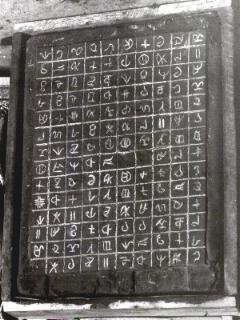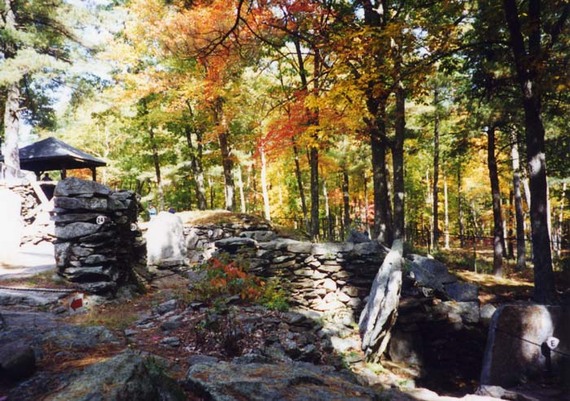A quick study of cable TV uncovers numerous programs purporting to use scientific techniques to uncover bizarre twists in history. Although card-carrying archeologists have long-since passed judgment on these ideas and moved on to far more interesting issues, pseudoarcheologists keep these ideas alive because (1) they sell books and bring in sightseers, (2) people are fascinated by the way they represent underdog ideas that "threaten" the establishment, (3) most people have no clue what scientific research is really all about, and (4) people view all scientists as equivalent experts on a given topic.
For example, the cable series America Uncovered identifies the investigator as a forensic geologist whose motto is "Sometimes history is not what we have been told." Apparently he has a degree from RPI in chemical engineering, which is not a relevant knowledge base for being an archeologist any more than being a chemist qualifies you to be a brain surgeon. The first artifact studied using this new "science of archaeopetrography was the Kensington Rune Stone, which has been offered as an authentic, pre-Columbian land claim carved here in America by none other than the Knights Templar. This should tip off many people that the principles of archeopetrography are probably not very sound and only supports the business storyline: "There is a hidden history in this country that no one knows about." In this case the stone's jumble of anachronistic rune text makes it a clear 19th-century forgery.
Ironically, the more conventional archeologists provide less far-fetched explanations the more they become the "narrow-minded establishment" distrusted in favor of a maverick, underdog. Underdogs, especially charismatic ones, are given the benefit of the doubt if they can come up with a plausible-sounding explanation or simply provide vague-though-intriguing assertions. This is also good for business, especially when it has to do with book publishing, TV appearances or bringing more tourists to your "controversial" site, which is usually what underdogs prefer to do.
Here are just a few "discoveries" that continue to make the TV circuit, and we are not even talking about UFOs and ghosts!
Photo of Newberry Tablet allegedly sent to the Smithsonian Institution circa 1896
The Newberry Tablet: Discovered in 1896 by sign painter James Scotford, this fragile clay tablet allegedly managed to survive thousands of years in damp Michigan soil but is only now deteriorating very rapidly. The tablet's "Minoan" hieroglyphs are actually a random mixture of all kinds of symbols. Even Mormon researchers who had a large vested interest in establishing Mediterranean influences in the New World declared the tablet and other relics in Michigan a fraud in 1909. A detailed materials analysis in 2001 concluded that the tablet and other Michigan relics were made with contemporary tools. The "discovery" of thousands of these relics stopped after the death of Scotford, who was generally credited with starting the Michigan Relics hoax.
Photo of part of Mystery Hill taken September 1993 (credit Stan Shebs/Wikimedia Commons)
America's Stonehenge:. Located in New Hampshire (formerly Mystery Hill), this site's history is muddled because of the activities of William Goodwin, who purchased it in 1937 and became convinced that the location was proof that Irish monks had lived there long before the time of Christopher Columbus, a concept he sought to publicize. The area has been altered by stone quarrying and by the efforts of Goodwin and others to move the stones to what they considered their original locations, with Goodwin perhaps responsible for much of what can now be seen in the many alleged astronomical alignments. Many of the stones have post-1830s drill marks from the quarrying that took place on the site even before Goodwin purchased it.
Cast of Grave Creek Stone (credit: Wikimedia Commons/public domain)
The Grave Creek Stone: This item is a small sandstone disk inscribed on one side with some 25 characters. It was discovered in 1838 in Moundsville, West Virginia. In October 2008 anthropologist David Oestreicher suggested that the inscription had been forged by James W. Clemens, a local physician who had financed the excavation of the site. Oestreicher found the source of the inscription in an 18th-century book on unknown letters on Spanish coins and monuments. Everything on the stone, including impossible sequences of characters with the same mistakes, was copied directly from this book.
The Sinaia lead plates: These items are a set of lead plates written in the Greek alphabet with a few other character additions, but they have been widely regarded by scholars as modern forgeries. According to folklore, the lead plates are copies made at the Nail Factory of Sinaia in 1875, from the originals, which were allegedly made of gold, and they were kept for a while at the Sinaia Monastery. An analysis made at the Institute of Nuclear Physics in Bucharest confirmed the plate composition is very similar to lead manufactured in the 19th century
The Shroud of Turin: In 1988 a radiocarbon-dating test was performed on small samples of the shroud. The samples dated from the Middle Ages, between 1260 and 1390. From an artistic and anatomical perspective, the shroud image follows the standard conventions of its time. The artistic errors are so severe that it is impossible for it to be the image of an actual human body. Writes Gregory S. Paul, "Exceptionally tall for his time and place [over 6 feet], his rather narrow head was so shrunken and low browed that it would have indicated a unique form of hypocephaly so serious it would have impaired his mental function."
Whether it's the passionate religious fervor stoked by the Shroud of Turin or racist, anti-Native American revisionist history, these "controversies" will continue to exist and be maintained because they are a good business proposition. Meanwhile, folks like professional archaeologist Peter Faris at his Rock Art Blog or Bad Archeology and Dr. Ronald Fritz at Planet Clio, to name just a few, continue to provide the much-needed dose of skeptical realism with no fancy TV programs to serve as their platforms.
Sometimes truth sucks!


